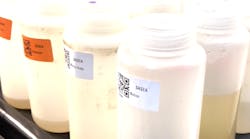During the COVID-19 pandemic, monitoring the levels of SARS-CoV-2 RNA in wastewater entering treatment plants has been one way that researchers have gauged the disease’s spread. But could the slimy microbial communities that line most sewer pipes affect the viral RNA they encounter?
In a first-of-its-kind study, researchers report in the American Chemical Society’s Environmental Science & Technology: Water that sewer slime can accumulate SARS-CoV-2 RNA, which could decompose or slough off later, potentially impacting the accuracy of wastewater epidemiology studies.
Previous researchers have shown that RNA viruses, such as poliovirus, enteroviruses and noroviruses, can get trapped and collect in the microbial biofilms that build up within the wastewater pipes. Yet whether the sticky material can also accumulate SARS-CoV-2 viral particles or RNA from wastewater was unknown.
To grow a simulated sewer slime, the researchers continuously pumped raw wastewater into a cylindrical tank with removable pieces of polyvinyl chloride (PVC) inside. They conducted two 28-day experiments, removing PVC plates every few days to assess the biofilm’s composition. Then the team used the method called reverse transcription quantitative polymerase chain reaction to measure the abundance of SARS-CoV-2 RNA and pepper mottle virus (an indicator of human feces) RNA in the untreated wastewater and the biofilms.
In August and September 2020, the levels of SARS-CoV-2 RNA were too low to accurately measure in both the simulated sewer slime and the wastewater from which it grew. These results align with a low incidence of COVID-19 infections at that time, the researchers say. Then, during November and December 2020, although SARS-CoV-2’s presence in the wastewater itself was still low, its RNA levels increased in the slime.
The amount of pepper mottle virus RNA plateaued within the first week of growth, indicating that the rise of SARS-CoV-2 RNA in the biofilm wasn’t because of a boost in fecal volume. Rather, this change reflected the higher number of diagnosed COVID-19 cases in late fall.
It’s still too early to know exactly how these biofilms impact wastewater epidemiology studies, since other factors need to be assessed first, say the researchers. For example, the RNA could get broken down, or it could be released into wastewater later on when the biofilms break apart.
The authors acknowledge funding from the U.S. National Science Foundation, the Rutgers Center for COVID-19 Response and Pandemic Preparedness and a Rutgers School of Graduate Studies Acceleration and Completion Fellowship.
The paper's abstract is available here.
Wastewater epidemiology has been a significant player in COVID-19 detection, able to detect the disease and its variants before an outbreak occurs. WaterWorld recently spoke with Smruthi Karthikeyan, a post-doctoral researcher in the University of California at San Diego's school of medicine, about her work in tracking COVID-19 variants through wastewater:




